

CHAPTER VII.
GROUPING AND ORGANIC FORM IN PAINTING, SCULPTURE, AND ARCHITECTURE
Places Corresponding to head, Trunk, and Feet in a Picture—
Necessity for considering them—
Different kinds of contour—
Arches—
Semicircles—
Pyramids—
Circles—
Ovals—
Wedge-Shapes—
Same Effects Produced by Light and Shade and Color, Differing on differing Sides, Above and below, at the Centre and at the Circumference—
Same Effects in Sculpture—
The Pedestal or foot, the canopy or head, on out-door statuary—
Architecture—
the Foot in the Foundation—
the trunk in the wall—
the head in the Roof—
Architectural grouping as a whole.
THE most cultured mind recognizes the superior attractiveness of paintings, statues, or buildings that seem to have “some head and tail,” —an expression through which plain people indicate how well they appreciate, in the arts appealing to sight, the characteristics that Plato designated by the terms head, trunk, and feet. A distinction needs to be drawn, however, between these terms as applied to a picture or statue, and to a figure of a man or animal that is represented in either. If a man, for instance, be represented as standing upright, his head will be at the top of the canvas, his feet at the bottom, and his trunk midway between them; and thus the organic form of the picture and of the man will correspond. But if he be represented in a foreshortened figure, plunging toward the spectator, his head may be at the bottom or in the centre of the canvas, and his feet
[The Genesis of Art-Form by G.L. Raymond, chapter VII, page 114]
at its sides or top; and the organic forms of the picture and of the man will not correspond. Accordingly, we must not confound the art-characteristics which have been indicated by the words head, trunk, and feet, with the same when applied literally to living objects.
Pictures are made to have the effect of organic form, as a result, of course, of order in the grouping; and for this almost everybody recognizes the necessity. Even in taking a common photograph an inexperienced operator will be careful to arrange a number of persons so as not to have them all sit in a row like the members of a negro minstrel troup. He will almost invariably place the larger or more prominent person or persons in the centre or at the top, thus giving the group a head; and the others on either side or below, thus giving it a trunk and feet; while he will also dispose of the whole party in such a way that the contour of the group, as outlined by all their forms together, shall seem to have some shape—that suggesting a circle, an arch, or a pyramid, as the case may be. The idea of producing these effects by the order in which different factors are grouped, is undoubtedly suggested by the appearances of things in nature, where organic form is a characteristic not only of individual fruits and leaves, but of whole clusters of them; and not only of whole trees, but even of the forests in which they grow. (See the trees in Fig. 47, page 157.)
In paintings perhaps the most common arrangement is one fulfilling the requirements of symmetry also, in which the contour caused by different forms at the top and sides of a picture suggest an arched line described from some centre of radiation below, while the bottom suggests a straight line. Usually, of course, what might be termed the head of the picture is near the apex of the arch, and the trunk
[The Genesis of Art-Form by G.L. Raymond, chapter VII, page 115]
is between that and the straight line which forms the feet. In this case the feet, which represent the foundation on which the whole rests, are made to appear, like the ground that underlies all objects in nature, particularly substantial. Effects of form produced through this method may be seen in the “Ezekiel” of Raphael, the “St. John” of Domenichino, the “St. Michael” of Guido, the “Poetry” of Kaulbach, and the “Transfiguration” of Raphael (Fig.46, page 147); as well as in numerous landscapes, in which the highest mountains are not at the sides, but usually near the centre of the picture, while the weightiest or darkest objects are at the bottom.
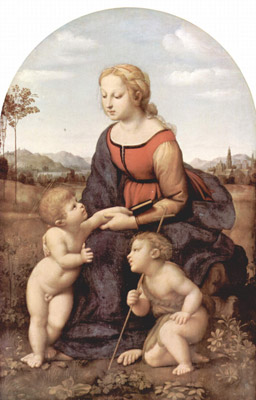 [click here to enlarge image]
[click here to enlarge image]
Fig. 38 – La Belle Jardiniere, by Raphael
This arrangement, however, by which the chief outlines at the top of the picture suggest a semicircular arch, and those at the bottom a broad and often a horizontal base, though common, is by no means universal. Sometimes, as in Raphael's “Sistine Madonna,” “La Belle Jardiniere” (Fig. 38, above), and “Del Passegio,” and in innumerable landscapes with mountains in the middle distance, the chief outlines at the tops and
[The Genesis of Art-Form by G.L. Raymond, chapter VII, page 116]
sides suggests the form of a pyramid rather than of an arch. Sometimes, as in Raphael's “Madonna della Sedia” (Fig. 39, below) and “Casa d'Alba,” the chief outlines at the bottom as well as at the top suggest a semicircle, causing the contour of the picture as a whole to seem circular; and sometimes, as in the “Madonna del Impannata” and the famous “Sistine,” the pitch of the arch both above and below is sharpened and a distinctly oval effect is produced, which, in the latter, has been described as a diamond.
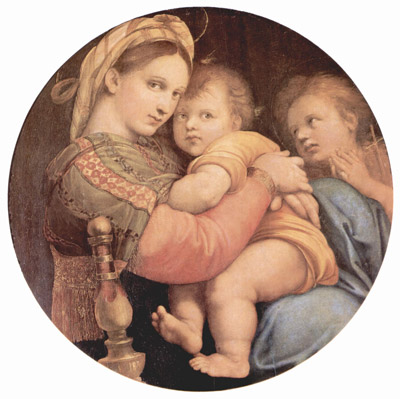 [click here to enlarge image]
[click here to enlarge image]
Fig. 39 – Madonna Della Sedia, by Raphael
These arches and pyramids are seldom perfect, the lines of the former being not always exactly rounded, nor of the latter exactly straight; but they are sufficiently regular to suggest the idea of organic form, and not only so, but of this produced as a result of design. As the same effect is imparted by almost any approximately symmetrical disposition of parts, artists resort to methods that, at first, would seem to suggest separation rather than unity. Thus a wedge-shape is produced by the outlines of buildings or mountains on one side of a picture which descend and near its middle meet the outlines of other buildings or mountains or forests, with or without buildings, which
[The Genesis of Art-Form by G.L. Raymond, chapter VII, page 117]
descend in a similar way on its other side (see Fig. 51, page 175); or the whole painting is divided into two parts, one containing forests or hills and the other plains, water, or sky (see Fig. 40, page 119).
As has been intimated already, the impression of form in nature, as in a cluster of berries or leaves, is conveyed not only by contour, but also—more or less closely connected with this—by color, especially as subjected to the influence of light and shade. In this way the “Organ Recital” by Henry Lerolle, in the Metropolitan Museum In New York, is diagonally divided into two parts, all the dark colors being at the left lower side of the picture and all the light colors at its right upper side. A somewhat similar arrangement characterizes also both of Corot's paintings that are in this book, namely Fig. 47, page 157 and Fig. 73, page 223.
Almost all great paintings indicate similarly artistic adjustments of color, which necessarily accompany, and often greatly enhance, the effects of form as produced by the contour. Usually, as in external nature, the lighter tints are above, in connection with what has been termed the head of the picture, and the dark and heavier shades below, in connection with what has been termed the foot (see Fig. 46, page 147). But sometimes colors in the body or at the centre of the picture are used almost independently of lines. Just as the play of light and shade upon a surface in nature reveals to us whether it be concave or convex, so the delineation of them upon canvas may cause features to seem to project or retire from the main ground, and thus influence what we may call the shape or form of the whole. This subject of the disposition of light and shade in the body of the canvas touches closely upon what was illustrated in connection with principality, and
[The Genesis of Art-Form by G.L. Raymond, chapter VII, page 118]
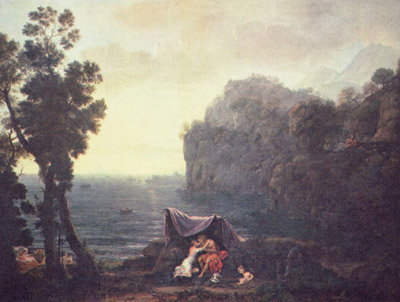 [click here to enlarge image]
[click here to enlarge image]
Fig. 40 – Evening, by Claude Lorrain
(See pages 31, 118, 146, 156, 172)
[The Genesis of Art-Form by G.L. Raymond, chapter VII, page 119]
will be further illustrated when we come to central-point and massing. It suffices to say here that, although the effects produced thus are sometimes, as by Rembrandt, carried so far as to appear unnatural, even then they are worth study. Indeed, if we wish to recognize how much more pleasing, as produced by this method, is an appearance of form in a composition than of formlessness, we can all do this to our entire satisfaction by comparing Correggio's “Holy Night” (Fig. 70, page 215), or Murillo’s “Holy Family” with the same subjects as treated by others failing to recognize the value of that which, now and then, these great artists were led to exaggerate.
The effect of organic form is produced in sculpture in the same general way, of course, as in painting. Whether the product contain a single feature or many features, the outlines of what Plato would term its head, like the outlines of a cluster of fruit around its stem, if not actually curved like an arch or tapered like a pyramid, at all events are not without good reason either square or even irregularly acute, and the base or foot is broad and substantial. Examples of this fact are furnished in almost all the classic statues. Notice, for instance, “Mithras Stabbing the Bull” (Fig. 54, page 179), the “Tauro Farnese,” “The Laocoon” (Fig. 75, page 226), Canova’s “Cupid and Psyche,” and, of single features, the “Ganymede” of the Vatican, and the “Fortuna” and “Reposing Faun” of the Capitol; also the Figures on pages 74 to 77.
These single statues, as a rule, have a pillar, or post, or drapery, or something at one side of them to enhance the width of the trunk. All of them, too, whether they be busts or of full length, rest upon a pedestal of dimensions ample enough to present the appearance of sufficient support (see fig. 41, page 121). This pedestal, of course, is the
[The Genesis of Art-Form by G.L. Raymond, chapter VII, page 120]
foot of the statue, considered as a whole. When the work that it supports is intended to stand within doors, the pedestal need not seem heavy. But when intended to stand in the open air, it should seem strong enough at least to resist the storms.
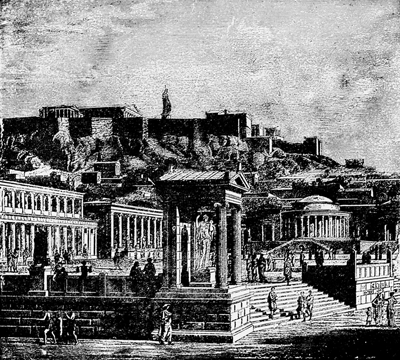 [click here to enlarge image]
[click here to enlarge image]
Fig. 41 – Market of Athens, Restored.
(See pages 79, 120, 122, 123, 289)
It is a question, indeed, whether, in the latter case, something should not be erected different in some regards from that which is to adorn the salon; it is a question whether, in our own climate especially, the finer products of this
[The Genesis of Art-Form by G.L. Raymond, chapter VII, page 121]
art, representing the human figure, should be left wholly exposed to the adverse influence of the weather. A canopy erected over them, of the same material as themselves, would certainly be appropriate and beautiful. (See the statue in the foreground of Fig. 41, page 121.) Very likely, too, a thoroughly cultivated taste would detect in this arrangement the only possible method of finishing the monument as a whole, in such a way as to give it not only the completeness of form manifested in a foot and trunk, but also in head.
The, necessity of organism is probably recognized more generally in architecture than in any of the other arts. If, for instance, we perceive columns, buttresses, or even dead walls, as they are termed, resting on the ground with no base, or foundation of any kind supporting them; or if, with this underneath, we perceive no cornice, frieze, entablature, or roof above them, in either case there will be suggested the idea of incompleteness. Our minds require here as in all the arts, the appearance of a foot, trunk, and head, which in architecture are represented by the foundation, wall, and roof. “The foundation,” says Mr. Ruskin in his “Stones of Venice,” “is to the wall what the paw is to the animal. It is a long foot, wider than the wall, on which the wall is to stand, and which keeps it from settling into the ground. It is most necessary that this great element of security should be visible to the eye, and therefore made a part of the structure above ground. The eye, taught by the reason, requires some additional preparation or foot for the wall, and the building is felt to be imperfect without it. The body of the wall”—corresponding to what in this essay has been called the trunk— “is of course the principal mass of it, formed of mud
[The Genesis of Art-Form by G.L. Raymond, chapter VII, page 122]
or clay, of brick or stones, of logs or hewn timber.” (See Figs. 1, 24, 61, pages 15, 79, 193.)
In addition to foot and trunk, corresponding to foundation and wall, the building must have a head, which, of course, can be represented only by the roof and its accompaniments. As Mr. Ruskin has been quoted with reference to the foundation and wall, he may as well be quoted with reference to the roof. “Has it never occurred to
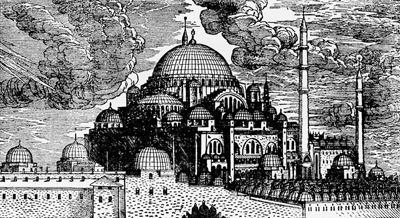 [click here to enlarge image]
[click here to enlarge image]
Fig. 42 – Old Picture of St. Sophia (Hagia Sophia), Constantinople.
(See pages 18, 76, 77, 96, 124, 180, 187, 190, 207, 261, 262.)
you,” he asks in the first of his “Lectures on Architecture,” “what effect the cottage would have upon your feelings if it had no roof? no visible roof, I mean. The very soul of the cottage, the essence and meaning of it are in its roof; it is that mainly wherein consists its shelter, that wherein it differs most completely from a cleft in rocks, or bower in woods. It is in its thick, impenetrable, cover-lid, its close thatch, that its whole heart and hospitality are concentrated. Consider the difference in sound of
[The Genesis of Art-Form by G.L. Raymond, chapter VII, page 123]
the expressions ‘Beneath my Roof’ and ‘In my Walls,’ and you will quickly see how important a part of the cottage the roof always must be to the mind as well as to the eye, and how, from seeing it, the greater part of our pleasure must continually arise. Now do you suppose that that which is so all important in a cottage can be of small importance in your own dwelling-house? Do you think that by any splendor of architecture—any height of stones—you can atone to the mind for the loss of this aspect of the roof?” (See Figs. 24, page 79; 28, page 84; 32, page 89; 33, page 90; 72, page 221; 85, page 258; and 69, page 208, as well as Fig. 42, page 123.)
Once more the general contour of a building may present effects of grouping similar to those already noticed in painting and sculpture. The various projections, gables, pediments, chimneys, domes, spires, whatever they may be, that make up the wings and roofs, may be arranged so that, taken together, they can be inscribed in a low or a high arch, rounded or sharpened like a pyramid. As a rule, the greater the appearance of the exercise of design in the organic arrangement of these features, the more satisfactory are they to the eye that looks to find in them the results of art. (See the “Taj Mahal,” Fig. 3, page 19; “St. Peter's, Rome,” Fig. 23, page 78; “Shadyside Church,” Fig. 34, page 91; “St. Mark’s, Venice,” Fig. 31, page 88; “Poutou Temple,” Fig. 69, page 208; “St. Hilaire’s, Rouen,” Pig. 80, page 237; “Tower of Boris, Moscow,” Fig. 83, page 279, and “St. Sophia's, Constantinople,” Fig. 42, page 123.)
[The Genesis of Art-Form by G.L. Raymond, chapter VII, page 124]